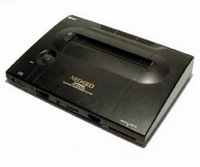
Neo Geo
SNK (Shin Nihon Kikaku, translated as "New Japanese Project"), a small third party software developer for the Nintendo NES, decided to try their hand in the arcade market in 1989. It seemed like a bad business decision since gamers no longer flocked to arcades. Nonetheless SNK released the MVS (Multi-Video System). The MVS allowed the arcade operator to house many different video games in a single cabinet.
 Phillips CD-i
Phillips CD-iIn the mid 1980’s Phillips and Sony partnered up to create a new CD standard containing interactive combinations of sound, images, and computer instructions. This CD standard also required specific types of players. So in 1991 Phillips created the Phillips CD-I 210 as a "multimedia" system capable of playing Interactive CD-I software discs, Audio CDs, CD+G (CD+Graphics), VCDs (Video CDs), and Karaoke CDs. You could essentially enjoy different types of media on the same machine.
People were not quite ready for the ‘multimedia’ experience and clung to their VCR’s, home computers, and video game consoles. With dwindling sales and with the videogame market doing well, Phillips decided to reintroduce the machine as videogame console. The Phillips CD-I 450 was designed to look more like a console and included a pack in game called "Burn Cycle".

Commodore 64GS
In 1982 a low cost home computer was released and achieved amazing success. The computer was called the Commodore 64.By 1990, Commodore set their attentions on the videogame console market. They followed the same concept as other computer companies (Fujitsu with the FM Towns Marty, and before that the Amstrad GX400, and the Amign CD32). Their new system was called the Commodore 64GS (GS = Game System). This unit was basically just a repackaged Commodore 64 computer without a keyboard, port access (Disk drive, etc), or standard ROM chip. Cartridges were loaded through the top port, and the machine came packaged with a joystick and a couple of games to get you started.Since the console was essentially a computer in new skin, it was compatible with all existing Commodore 64 carts. The Commodore 64GS also spurred development of newer cartridges released specifically for the console.The C64GS never achieved the level of success that it's computer big brother did. For a little more money you could own the Commodore 64 computer (cheaper by this time) and still play the same carts, a vast library of disk / cassette games (Not to mention other computer perks). The console suffered poor sales and was pulled from store shelves. It was never released outside of Europe

0 Comments:
Post a Comment
<< Home